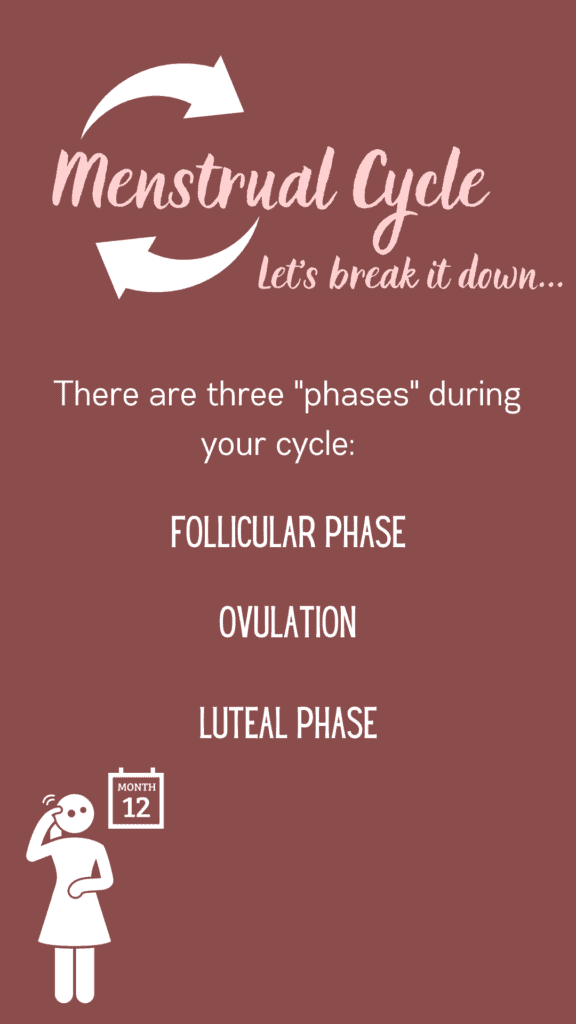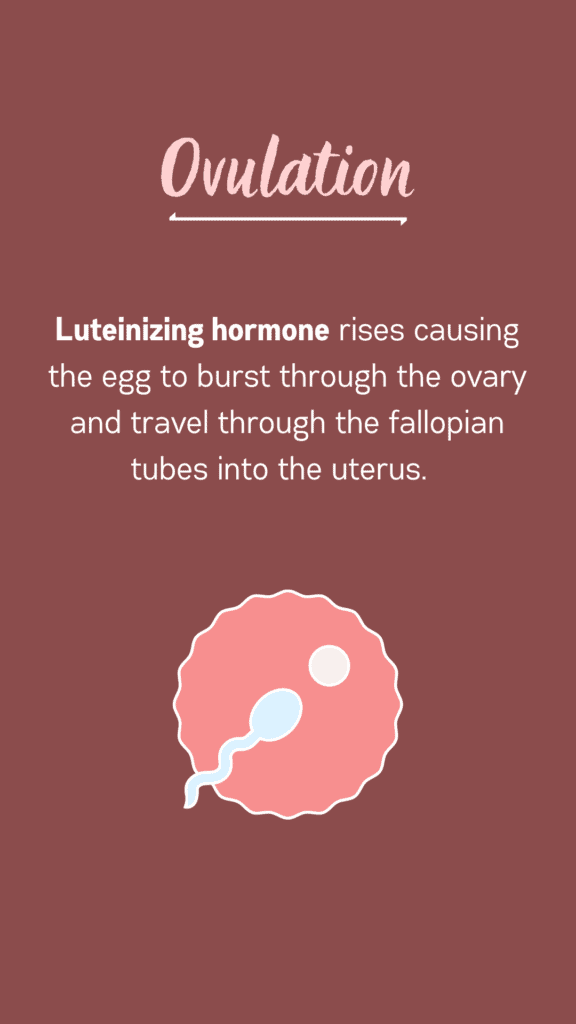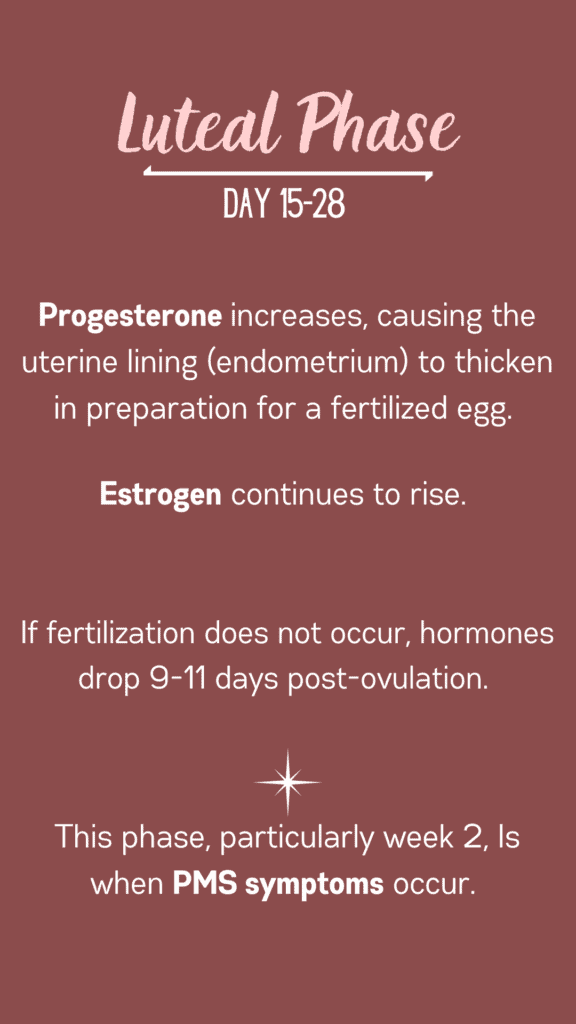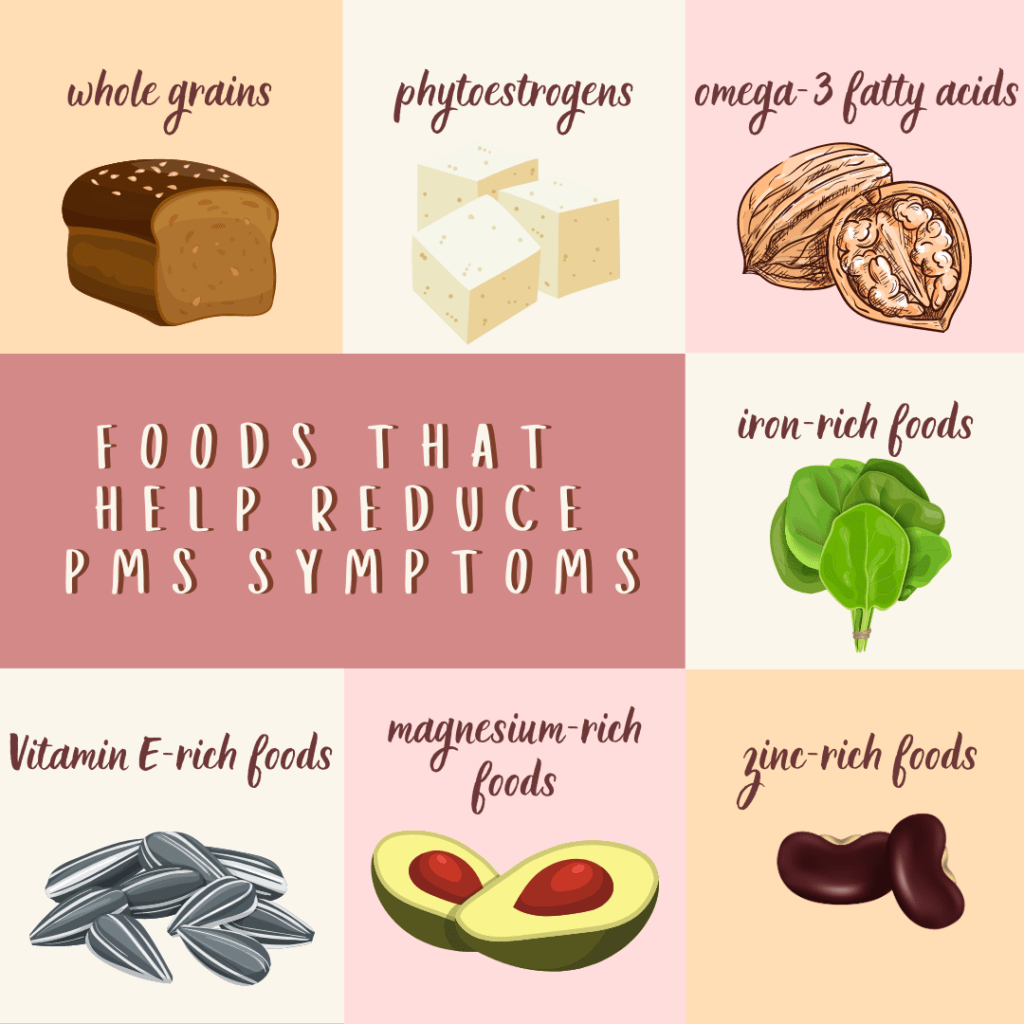What to eat (and avoid) during each phase of the menstrual cycle. The best foods for PMS symptoms & foods that make symptoms worse.
Table of contents
- Phases of the menstrual cycle
- Follicular Phase
- Ovulation
- Luteal Phase
- Why do you get cramps during the luteal phase?
- How the menstrual cycle affects athletic performance
- Best foods to manage PMS symptoms
- Do certain nutrients ease PMS symptoms?
- Foods to avoid when you’re PMS-ing
- Putting it all together
- Know your cycle
Most women think of their period as the 5-8 days each month when they experience bleeding, cramps, bloating, fatigue, and mood shifts. As a matter of fact, an estimated 80- 90% of all women experience one or more of these symptoms.
However, the menstrual cycle encapsulates hormonal changes occurring over 24-38 days (with an average of 28 days). This recurring cycle prepares the uterus for a (potential) pregnancy.
Phases of the menstrual cycle
The menstrual cycle is split up into two phases: the follicular phase and the luteal phase. The follicular phase length varies more than the luteal phase, which is consistently around 12-14 days. In between these two phases, ovulation occurs. Let’s take a look at the timeline of the average menstrual cycle.

Follicular Phase
Day 1 of your cycle begins with menstruation or the shedding of the lining of the uterus. This is the time most often referred to as a “period.”
The beginning of menstruation is also the start of the follicular phase. This phase varies in length, and it’s marked by an increase in estrogen levels. During the follicular phase, the brain uses a hormone called follicle-stimulating hormone (FSH) to send a message to the ovaries to release an egg for ovulation.
Let’s look more closely at estrogen and FSH…

Estrogen
There are three naturally occurring forms of this hormone: estrone, estradiol, and estriol. Of these, estradiol is the one that we are most concerned with and has the greatest impact on physical and mental changes throughout the menstrual cycle.
Estrogens are responsible for growth, development and maintenance of sex characteristics (ie higher vocal cords, female body shape, breast growth), the growth of the uterus, the release of luteinizing hormone (more on this later), the thickening of the vaginal wall, and the development of milk ducts in the breast during pregnancy.
The primary action of estrogen, in terms of menstruation, is the thickening of the uterine lining, also known as the endometrium. This thickening creates a hospitable environment for the potential fertilized egg to grow.
Follicle-Stimulating Hormone (FSH)
This hormone is created by the pituitary gland, which is located at the base of the brain. It’s responsible for estrogen production inside the follicle–a little fluid-filled sac within a woman’s ovaries that contains an egg.
Each follicle releases one egg for fertilization; for this reason, “follicle” is often used interchangeably with “egg.” Although there are many follicles in each ovary, there is only one principal follicle that is released at ovulation. This main follicle produces estrogen as it grows within the ovary.
Ovulation
Around day 14, ovulation occurs and marks the time between the follicular and luteal phases. The time of ovulation can vary based on the length of your normal cycle. It usually occurs around Day 14 for a 28 day cycle, but it may be later for a longer cycle.
Before ovulation, the matured egg or follicle produces estrogen, which signals the brain to increase luteinizing hormone.

Luteinizing Hormone (LH)
Like follicle stimulating hormone, luteinizing hormone is also made by the pituitary gland. It plays an important role in sexual development and function. Right before ovulation, LH rises rapidly, which triggers the release of the egg from an ovary.
The egg breaks through the wall of the ovary, starting ovulation. The released egg travels along the fallopian tube into the uterus. Although the egg only survives in the uterus for about 24 hours, sperm can survive in the female body for up to five days.
The period when the egg can be fertilized by the sperm is called the “fertile window”. A non-fertilized egg will disintegrate and leave the body at the beginning of a new menstrual cycle (about 12-16 days after ovulation).
Luteal Phase
The luteal phase occurs around days 15-28. It begins after ovulation and lasts until the start of a new menstrual cycle, i.e. the first day of bleeding. The follicle that contains the egg in the ovary turns into a corpus luteum and produces progesterone and estrogen.

Progesterone
The corpus luteum secretes progesterone, a hormone that thickens the uterine lining in preparation for a fertilized egg. If fertilization does not occur, the corpus luteum breaks down 9-11 days post-ovulation and is shed from the body.
This results in a drop in estrogen and progesterone levels. If an egg is fertilized during ovulation, progesterone continues to rise.
The luteal phase is associated with “premenstrual” (PMS) symptoms, such as headaches, acne, bloating, tender breasts, mood changes, nausea and/or vomiting. In fact, there are over 150 different symptoms associated with PMS!
Why do you get cramps during the luteal phase?
During the luteal phase, the increase in progesterone levels cause the lining of the uterus (endometrium) to stop thickening in order to receive and attach a fertilized egg. This period is also called the “secretory phase” because the endometrium produces chemical messengers (hormones), such as prostaglandins.
Prostaglandins widen blood vessels, increase blood flow and help the uterus contract and relax, allowing the thickened endometrium to detach from your uterus and flow out of your body during your period.
You experience cramping when an excess of prostaglandins causes the uterus to contract so strongly that it reduces blood flow to the uterus. Don’t be alarmed! This process is normal and necessary.
However, if you experience debilitating or unbearable pain, talk to your healthcare provider about possible medications or other solutions. NSAIDS (non-steroidal anti-inflammatory drugs), such as aspirin and ibuprofen, block the actions of prostaglandins, therefore lessening pain from cramps.
How the menstrual cycle affects athletic performance
As you can see, there are a LOT of hormonal changes happening throughout a woman’s body during the menstrual cycle. The good news is that exercise has been shown to reduce period pain!
Remember those pesky prostaglandins from the luteal phase? Exercise counteracts the effects of prostaglandins, increasing blood flow to the abdomen and uterus, which results in fewer and less intense cramps!
Generally speaking, during the first half of your cycle (follicular phase), right after the first day or two of bleeding, you may have more energy and experience a more stable mood due to the increasing hormones. The week before ovulation is the perfect time to do higher intensity or longer workouts, such as HIIT, long runs, boxing, rowing or swimming.
The second half of the cycle (luteal phase) is when you’re more likely to feel lethargic. During these two weeks, hormone levels are dropping but prostaglandins are increasing, so you may experience gastrointestinal issues, migraines, and a drop in serotonin.
Pay attention to your energy levels and how you feel. Lower intensity exercises, such as yoga, pilates, and walks, will get your blood flowing without exacerbating your symptoms. It’s a good idea to get adequate sleep during the luteal phase, which will ensure you’re not completely foggy and zapped of energy during the day.
The menstrual cycle, a recurring sequence of hormonal changes over roughly 24-30 days, has many coinciding symptoms, such as mood swings, bloating, cramping, fatigue, and gastrointestinal issues. As a matter of fact, there are over 140 different symptoms that have been associated with menstruation!
It can be overwhelming to understand all the different changes that happen in your body from month to month, let alone figure out how to manage them. Ibuprofen and aspirin have their time and place, but slightly altering your diet patterns throughout the month will help naturally manage the unpleasant symptoms.

Best foods to manage PMS symptoms
Not only are plant-based diets beneficial for a number of diseases, they have also been shown to lower PMS symptoms. Low- fat, high-fiber vegetarian diets have been associated with decreased overall inflammation and fewer and less painful menstrual symptoms.
Additionally, high-fiber diets (20-35 g/day) help eliminate estrogen from the body. Estrogen is the hormone partially responsible for hot flashes, mood swings and tender breasts. Fiber binds to estrogen in the intestine, increasing estrogen excretion in bowel movements.
Let’s take a closer look at the type of foods that are rich in fiber and help manage PMS symptoms.
Whole grains
These have been shown to slow down the production of prostaglandin, the hormones that cause cramps during the luteal phase. It’s important to eat whole grains all month long, but definitely include complex, fiber-rich grains in your diet from cycle days 15-28. Here are some examples:
- barley
- quinoa
- oatmeal
- brown rice
- farro
- spelt
- wheatberries
- popcorn
- sorghum
Foods with phytoestrogens
Phytoestrogens are plant-derived compounds that compete with other estrogens for receptor binding. They have been shown to lengthen the follicular phase by an average of 2.5 days, therefore lowering peaks of LH and FSH and reducing the length of the luteal phase (when PMS symptoms occur).
The plant foods highest in phytoestrogens:
- soy products: tempeh, tofu, soy beans, soy milk
- legumes: beans, peas
- flaxseeds and sesame seeds
- apples and carrots
Omega-3 fatty acids
Omega-3’s, a type of “good” fat, have been shown to have anti-inflammatory actions. Inflammation, which is the immune system’s response to infection and injury, may cause an increase in cramp-inducing prostaglandins.
In the week leading up to your period, eat more of these omega-3 rich foods:
- Nuts, especially walnuts
- Seeds, like chia seeds, pumpkin seeds and hemp seeds
- Avocados
- Oils, like olive oil
Do certain nutrients ease PMS symptoms?
Certain micronutrients may help alleviate PMS symptoms, so include plenty of these in your diet throughout the month.
Iron
Iron- rich foods have been shown to decrease brain fog, cramping, fatigue, and mood swings associated with your period. Animal foods are high in iron, but these plant-based foods also contain ample amounts of this important micronutrient:
- chickpeas
- spinach
- oats
- tofu
- lentils
- cashews
- edamame
- dark chocolate
Zinc
This mineral has been shown to decrease the metabolism of prostaglandins, therefore decreasing cramps. Eat these foods for your daily dose of zinc:
- legumes (lentils, chickpeas, beans)
- seeds (hemp, pumpkin, sesame)
- nuts (pine nuts, cashews, almonds)
- whole grains (wheat, quinoa, rice, oats)
Magnesium and Vitamin B6
These nutrients together have been shown to decrease PMS symptoms by relaxing the muscular contractions in the uterus (i.e. what causes the painful cramp-feeling). You don’t have to eat this mineral and vitamin at the same time to reap the benefits.
- Foods high in magnesium: pumpkin seeds, almonds, spinach, cashews, peanuts, soy milk, black beans, edamame, avocado,
- Foods high in Vitamin B6: peanuts, soy beans, wheatgerm, oats, bananas, some fortified cereals
Vitamin E
This vitamin also suppresses prostaglandin production and decreases their concentration in the bloodstream. Foods rich in Vitamin E includes:
- sunflower seeds
- nuts, like almonds, hazelnuts and walnuts
- peanuts/peanut butter
- spinach, broccoli, red pepper, turnip greens, beet greens, butternut squash, mustard greens
Foods to avoid when you’re PMS-ing

Certain foods will make you feel worse when you’re experiencing PMS symptoms during the luteal phase. Try to avoid these foods during this time.
Alcohol
Although you may feel like you need a drink, alcohol is a diuretic, meaning that you lose more liquid than you take in. Alcohol consumption can lead to dehydration, which can increase the severity of nausea and headaches, which are PMS symptoms. Try to keep your alcohol intake to a minimum the week before your period.
Ultra-processed foods
A diet high in refined grains and ultra-processed foods is usually low in fiber. Without adequate fiber intake, the estrogen rises and makes you feel awful. Try to keep ultra-processed foods to a minimum, including:
- white bread
- refined cereals
- pastries
- fried foods
- doughnuts and other sweets
Excessive Omega-6’s
You may have heard that omega-3s are the golden child of the fatty acids, and that you should not consume omega-6 fatty acids (found mostly in vegetable oils). That’s not necessarily the case.
It’s more important to eat a balanced ratio of both omega-3’s and omega-6’s, rather than completely eliminate omega-6 ‘s from your diet. Generally speaking, a diet rich in processed foods contains an omega-6 to omega-3 essential fatty acid (EFA) ratio of 15:1, but the healthy ratio is more like 1:1.
Omega-6 unsaturated fatty acids are precursors to prostaglandins and associated with increased inflammation. Therefore, during the luteal phase, minimize your consumption of:
- high fat foods, like sour cream, mayonnaise and butter
- certain oils: safflower, sunflower, soybean
- processed foods
Putting it all together
As you can see, lifestyle modifications can play a big role in the severity of your menstrual cycle symptoms. But you may be asking yourself, “How can I apply all this information to my own cycle?”.
There are 4 phases of the menstrual cycle. Let’s break it down day by day (keep in mind the exact days are according to a 28-day cycle, but each person’s cycle may differ by a few days).
Day 1: First day of bleeding (i.e. your period starts) and the first day of the follicular phase. Hormones (estrogen and progesterone) are low. You may be feeling depressed, irritable, increased appetite, and low energy.
This is a time to avoid alcohol completely, because it can increase the intensity of these mood swings. On the first day of your period, eat iron-rich foods (to counteract the iron lost through blood loss), such as eggs, sunflower seeds, tofu and chocolate! Reduce foods that can exacerbate bloating, such as high-fat foods, spicy foods, starchy foods w/yeast, and foods high in salt.
Day 7: You’re in the middle of the follicular phase. Estrogen is on the rise! You are most likely feeling a surge of energy due to a boost in those “feel good” endorphins. Also, you’re most likely relaxed and emotionally less reactive.
Even though you may have stopped bleeding, continue to eat iron-rich foods to make up for the iron from blood loss. Throughout the week, your energy levels should gradually increase. Fiber-rich foods, such as legumes, fruits, and vegetables, will also make sure that the excess estrogen being produced is properly cleared out of the body.
If you’ve been wanting a night out on the town with a drink or two, this is the time for it! In general, from day 7 to ovulation, you can be the most relaxed with your diet and still feel good.
Day 14: Ovulation occurs and your “fertile window” is open for 12-24 hours. Estrogen peaks right before ovulation, which increases luteinizing hormone, the hormone that stimulates the release of the egg from the follicle into the uterus.
You’re about to experience a drop in hormone levels. Plan out a grocery list that contains all the foods that will help you combat those unfavorable premenstrual symptoms (PMS).
Day 15: This marks the beginning of your luteal phase. The ruptured follicle is making progesterone, which further thickens your uterine lining in preparation for fertilization. There is a slight decrease in estrogen, which can zap you of the energy you had pre-ovulation. You might be feeling foggy and fatigued and experiencing fluid retention and headaches. Avoid alcohol to prevent a worsening of headaches.
A little caffeine could help with fluid retention and fatigue, but make sure you drink plenty of water. Reduce simple carbohydrates and sugar to stabilize glucose and energy levels. Eat fiber-rich foods with healthy fats, such as avocado, nuts, and seeds to increase satiation and fight cravings.
Day 24: You’re in the middle of the luteal phase. If your egg is not fertilized, estrogen and progesterone drop, causing more extreme mood changes like anxiety, irritability, and depression. This time is what’s often referred to as the PMS week.
The two weeks of the luteal phase require the most attention to diet to combat unwanted symptoms. Continue to eat a diet of whole grain, which can combat those sugar and starch cravings. Avoid processed foods, alcohol, and animal products. Increase your consumption of dark leafy greens (collared greens, kale, spinach, chard), grains (quinoa, amaranth, teff, black rice), fruits berries, cherries, grapefruit, apples, oranges, pears), omega-3 rich fats (avocado, extra virgin olive oil, hemp seeds, walnuts), high-protein zinc-containing foods (lentils, chickpeas, beans), magnesium-rich seeds (pumpkin seeds and chia seeds), and vitamin E- containing vegetables (broccoli, red peppers, turnip greens, butternut squash).
Know your cycle
To get the most out of this information, start tracking your cycle (if you are not already). Those slight hormonal fluctuations from one phase of the cycle to the next can result in dramatically different symptoms.
Apps such as Flo or Clue can help keep you on top of your cycle and symptoms. Avoid the surprise of PMS every month by planning meals that can facilitate a more pleasant period experience.


0 Comments